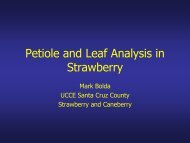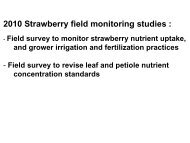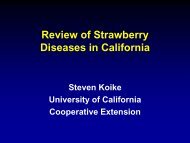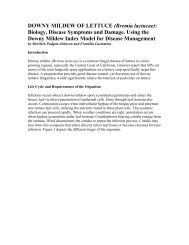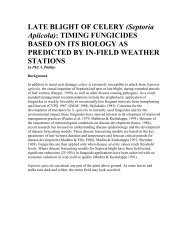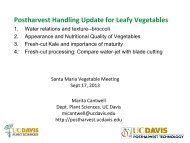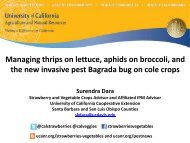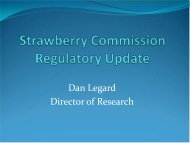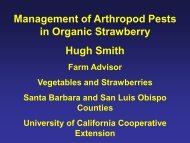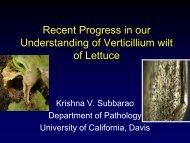Dara-New technologies for strawberry plant health and yield
Dara-New technologies for strawberry plant health and yield
Dara-New technologies for strawberry plant health and yield
Create successful ePaper yourself
Turn your PDF publications into a flip-book with our unique Google optimized e-Paper software.
<strong>New</strong> <strong>technologies</strong> <strong>for</strong> improving <strong>strawberry</strong> <strong>plant</strong> <strong>health</strong> <strong>and</strong> <strong>yield</strong><br />
Surendra <strong>Dara</strong><br />
Strawberry <strong>and</strong> Vegetable Crops Advisor <strong>and</strong> Affiliated IPM Advisor<br />
University of Cali<strong>for</strong>nia Cooperative Extension, San Luis Obispo <strong>and</strong> Santa Barbara Counties<br />
Under the soil is a complex <strong>and</strong> dynamic world of moisture, pH, salinity, nutrients, microorganisms, <strong>and</strong> <strong>plant</strong><br />
roots along with pests, pathogens, weeds <strong>and</strong> more. A good balance of essential nutrients, moisture, <strong>and</strong><br />
beneficial microorganisms is critical <strong>for</strong> optimal <strong>plant</strong> growth <strong>and</strong> <strong>yield</strong>. Healthy <strong>plant</strong>s maintain a good<br />
balance of nutrients <strong>and</strong> natural <strong>plant</strong> defense compounds that help them withst<strong>and</strong> stress caused by biotic<br />
<strong>and</strong> abiotic factors.<br />
There are some products that promote <strong>plant</strong> growth <strong>and</strong> improve <strong>health</strong>, <strong>yield</strong> potential <strong>and</strong> quality. Some<br />
have mycorrhizae while others have a blend of micro <strong>and</strong>/or macro nutrients that are utilized by <strong>plant</strong>s as well<br />
as beneficial microorganisms in the soil that promote <strong>plant</strong> <strong>health</strong>. In addition to the macro nutrients such as<br />
nitrogen, phosphorus, <strong>and</strong> potassium, several micro nutrients are critical <strong>for</strong> optimal growth <strong>and</strong> <strong>yield</strong><br />
potential. Underst<strong>and</strong>ing the <strong>plant</strong>-microbe-nutrient interactions <strong>and</strong> how different products help crop<br />
production are important <strong>for</strong> making appropriate decisions.<br />
Mycorrhizae or fungi of roots establish a symbiotic relationship with <strong>plant</strong>s <strong>and</strong> serve as an extended network<br />
of the root system. They facilitate improved uptake of moisture <strong>and</strong> nutrients resulting in better <strong>plant</strong> growth<br />
<strong>and</strong> <strong>yield</strong>. Mycorrhizae can absorb certain nutrients more efficiently than <strong>plant</strong>s <strong>and</strong> make them more readily<br />
available <strong>for</strong> the <strong>plant</strong>. With increased moisture <strong>and</strong> nutrient absorption, <strong>plant</strong>s become more drought<br />
tolerant. Healthy root system can fight soil diseases <strong>and</strong> weed invasion. Additionally, mycorrhizae increase<br />
organic matter content <strong>and</strong> improve soil structure.<br />
Study 1 - Beneficial microorganisms <strong>for</strong> improved <strong>strawberry</strong> <strong>plant</strong> <strong>health</strong>:<br />
This study was conducted using <strong>strawberry</strong> <strong>plant</strong>s grown in raised beds (20X5X2’). Strawberry trans<strong>plant</strong>s<br />
(cultivar Monterey) were treated by applying treatment materials to the <strong>plant</strong> base. Trans<strong>plant</strong>s were <strong>plant</strong>ed<br />
in beds after 48 hours <strong>and</strong> regularly watered <strong>and</strong> fertilized (with fish emulsion). Plant growth, <strong>health</strong><br />
conditions, <strong>and</strong> <strong>yield</strong> were periodically monitored.<br />
HYTA: HYTA contains soil-based microorganisms that fix atmospheric <strong>and</strong> applied nitrogen, solubilize nutrients,<br />
<strong>and</strong> build soil organic matter.<br />
Beauveria bassiana: B. bassiana is a soil inhabiting fungus which is pathogenic to several arthropod pests. It is<br />
known to colonize some <strong>plant</strong>s as an endophyte (symbiont that lives inside a <strong>plant</strong> without causing a disease)<br />
<strong>and</strong> provide protection against arthropod pests feeding on those <strong>plant</strong>s. Some isolates are also known to be<br />
antagonistic to <strong>plant</strong> pathogens.<br />
Untreated control: Plants were not inoculated with any material.<br />
Results: Plant <strong>health</strong> appeared to be superior <strong>for</strong> <strong>plant</strong>s treated with B. bassiana (3.5/5.0) followed by those<br />
treated with HYTA (3.1/5.0) <strong>and</strong> untreated control (2.7/5.0) although differences were not statistically<br />
different.<br />
1
Plant Health Rating<br />
3/1/2013<br />
3/3/2013<br />
3/5/2013<br />
3/7/2013<br />
3/9/2013<br />
3/11/2013<br />
3/13/2013<br />
3/15/2013<br />
3/17/2013<br />
3/19/2013<br />
3/21/2013<br />
3/23/2013<br />
3/25/2013<br />
3/27/2013<br />
3/29/2013<br />
3/31/2013<br />
4/2/2013<br />
4/4/2013<br />
4/6/2013<br />
4/8/2013<br />
4/10/2013<br />
4/12/2013<br />
4/14/2013<br />
4/16/2013<br />
4/18/2013<br />
4/20/2013<br />
4/22/2013<br />
4/24/2013<br />
4/26/2013<br />
4/28/2013<br />
5<br />
HYTA B. bassiana Control<br />
4<br />
3<br />
2<br />
1<br />
0<br />
Study 2 - Impact of endophytic Metarhizium brunneum on spider mites:<br />
In a greenhouse study <strong>for</strong> evaluating the ability of Metarhizium brunneum to colonize <strong>strawberry</strong> <strong>plant</strong>s, there<br />
was an unexpected infestation by twospotted spider mites. Plants inoculated with M. brunneum appeared to<br />
withst<strong>and</strong> mite infestation <strong>and</strong> resulting damage better than untreated controls. Like B. bassiana, M.<br />
brunneum is a soil inhabiting fungus which is pathogenic to various arthropods.<br />
2
Cull Weight (g)<br />
Study 3 - Recycled food-based fertilizer <strong>for</strong> improved <strong>strawberry</strong> <strong>yield</strong>s:<br />
Research is under way using a liquid fertilizer called<br />
Harvest-to-Harvest (H2H) made from recycled produce,<br />
meat, <strong>and</strong> other food items. Food waste is enzymatically<br />
digested <strong>and</strong> made into a liquid fertilizer that contains<br />
nitrogen, phosphorous <strong>and</strong> potassium (1-1-0), 18 amino<br />
acids (5-7%), lipids (6-8%), carbohydrates (8-10%), <strong>and</strong><br />
organic matter (20-25%). H2H also contains small amounts<br />
of aluminum, calcium, copper, iron, magnesium,<br />
manganese, sodium, sulfur, <strong>and</strong> zinc. A large field study is in progress to evaluate the efficacy of H2H alone (73<br />
gpa) <strong>and</strong> in combination with the grower st<strong>and</strong>ard (H2H:GS 50:50) to compare with the st<strong>and</strong>ard fertilization<br />
program (GS) followed by the grower. Treatments were applied on 3/28, 4/9, <strong>and</strong> 4/18.<br />
Results: So far, H2H alone <strong>and</strong> in combination with the grower st<strong>and</strong>ard produced 32-40% higher <strong>yield</strong>s<br />
compared to the grower st<strong>and</strong>ard alone. There was no difference in the unmarketable fruit <strong>yield</strong> among<br />
treatments.<br />
GS H2H H2H:GS<br />
300<br />
250<br />
200<br />
150<br />
100<br />
50<br />
0<br />
4/4/2013 4/8/2013 4/11/2013 4/15/2013 4/18/2013 4/22/2013 4/25/2013 4/29/2013<br />
3
Seasonal average (g)<br />
Fresh Weight (g)<br />
GS H2H H2H:GS<br />
1200<br />
1000<br />
800<br />
600<br />
400<br />
200<br />
0<br />
4/4/2013 4/8/2013 4/11/2013 4/15/2013 4/18/2013 4/22/2013 4/25/2013 4/29/2013<br />
Cull Weight<br />
Fresh Weight<br />
800<br />
700<br />
a<br />
a<br />
600<br />
500<br />
b<br />
400<br />
300<br />
200<br />
100<br />
0<br />
GS H2H H2H:GS<br />
Acknowledgements: I would like to thank the following <strong>for</strong> their collaboration, financial support, or technical<br />
assistance - Daren Gee <strong>and</strong> Joe Coelho, Daren’s Berries, Dan Morash, Cali<strong>for</strong>nia Safe Soils, Mark Abildgaard,<br />
Agrinos, Andres Tapia, Cal Poly, inmate G in Maximizing Education Reaching Individual Trans<strong>for</strong>mation<br />
Program, Adrianne Ferree <strong>and</strong> Brant Choate, Los Angeles County Sheriff’s Department.<br />
Surendra <strong>Dara</strong> PhD, DAIT<br />
Strawberry <strong>and</strong> Vegetable Crops Advisor <strong>and</strong> Affiliated IPM Advisor, UC Cooperative Extension, 2156 Sierra Way, Ste. C, San Luis<br />
Obispo, CA 93401, Phone: 805-781-5940, Fax: 805-781-4316, Email: skdara@ucdavis.edu<br />
Articles: http://ucanr.edu/strawberries-vegetables <strong>and</strong> http://ucanr.edu/pestnews <strong>New</strong>sletter: http://ucanr.edu/ccah<br />
Meeting presentations: http://ucanr.edu/meetingpresentations<br />
Twitter: @calstrawberries <strong>and</strong> @calveggies Facebook: www.facebook.com/strawberriesvegetables<br />
4



